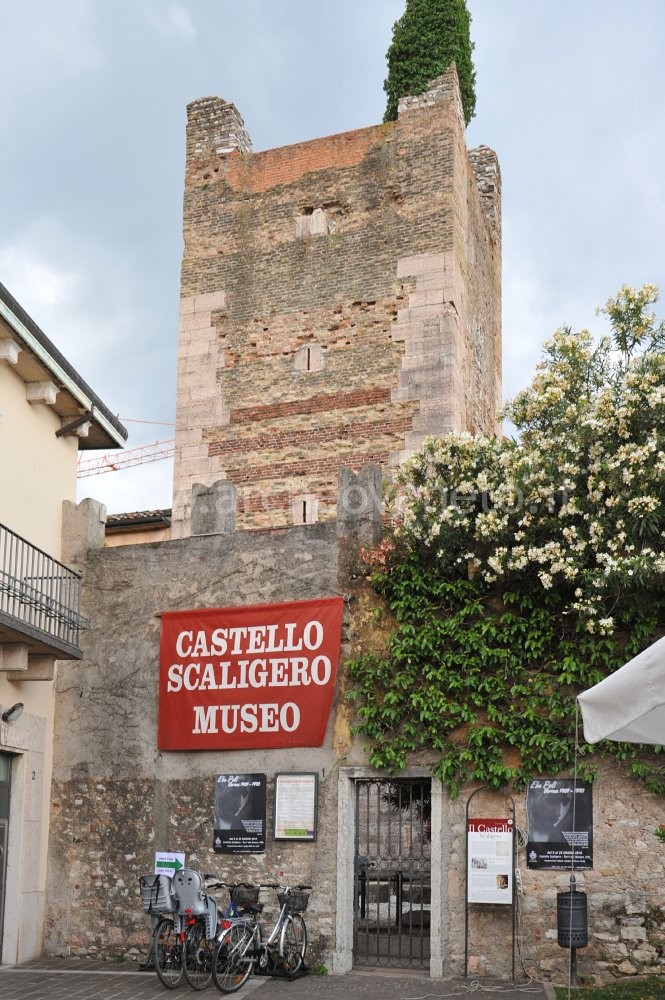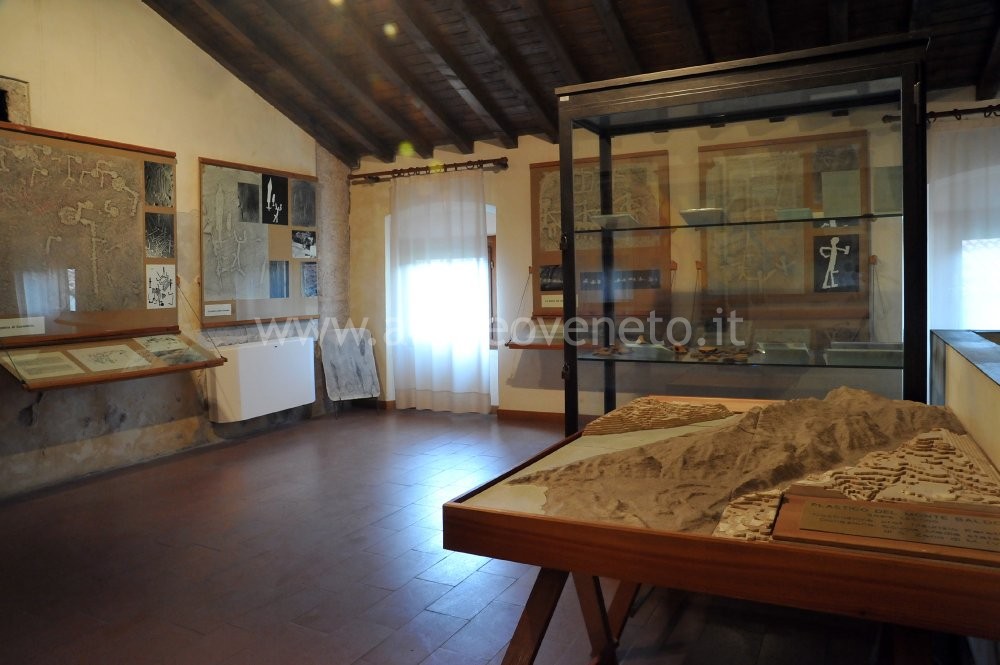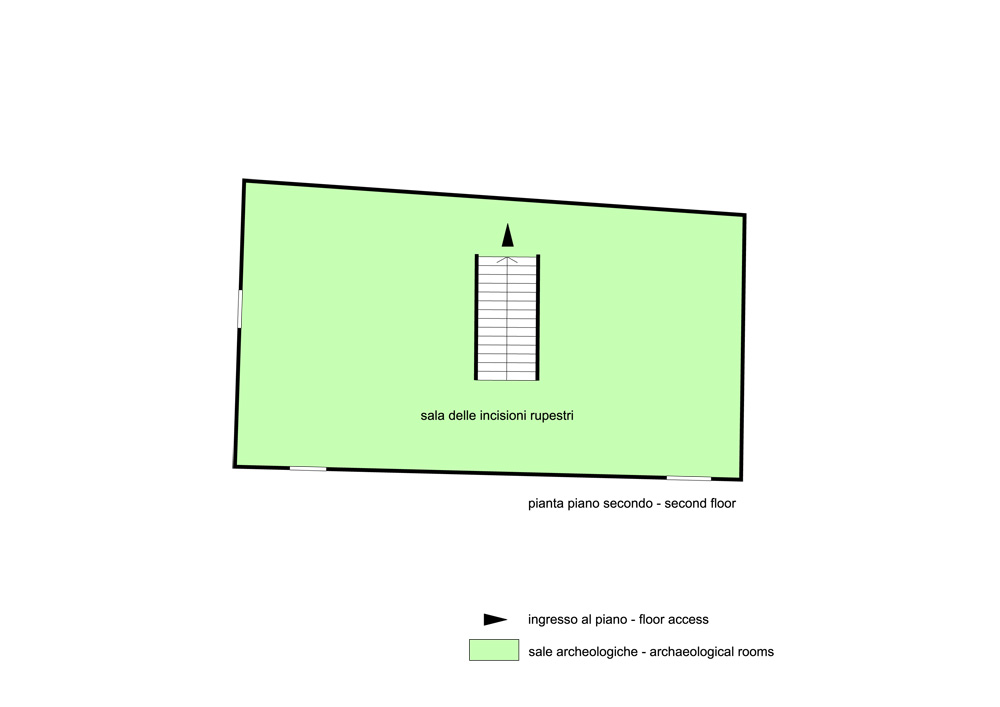|
|
File
Museum of the Scaliger Castle – Torri del Benaco
|
Viale Fratelli Lavanda 2 – 37010 Torri del Benaco (VR)
– Fax 045 6296111 |
  |
|
Summary

The castle of Torri del Benaco built in 1383 and commissioned by Antonio della Scala, is the current venue of the Museum of the Scaliger Castle, which opened in 1983 after a large renovation work. Some aspects of the material culture of Torri del Benaco are illustrated in the museum rooms going from olive growing to fishing to the archaeological finds and rock engravings found along the banks of the Garda Lake.
Collection history
The first rock engravings were discovered along the banks of the Garda Lake (from Garda to Malcesine) in 1964 by professor Mario Pasotti. During his surveys, he was soon supported by a team of young people and by some scholars from the City Museum of Natural History of Verona who, thanks to their support, allowed him to detect an increasingly high amount of engraved rocks and to catalogue them in a corpus. In 1985, thanks to Fabio Gaggia, who brought on the work of Prof. Pasotti, it was possible to establish the Centre for Regional Studies of Benaco (Centro Studi per il Territorio Benacense); shortly thereafter the Museum of Torri was founded, which became soon an important reference point for the study of the graffiti of the Garda area.
|

 The visit to this room, which focuses on the technique of engraving or drawing on the rocky walls of the mountains, starts with an introductive panel illustrating the areas where the most of rocky art samples have been found along the eastern banks of the Garda lake. The panel is located next to some pictures showing the finding of the engravings. The visit to this room, which focuses on the technique of engraving or drawing on the rocky walls of the mountains, starts with an introductive panel illustrating the areas where the most of rocky art samples have been found along the eastern banks of the Garda lake. The panel is located next to some pictures showing the finding of the engravings.
In the graffiti of the Garda lake, the most frequent topics are: weapons, knights, the human figure, religious symbols, the game of Nine Men’s Morris and ships.
As far as the weapons (axes, daggers and swords) reproduced on the drawn rocks are concerned, they are very useful to help date the engravings as they find a precise location in the archaeological finds of the Bronze and Iron Age. Two important steles depicting pre- and protohistoric weapons are the stone of Castelletto (five square meters depicting nearly seventy axes and eight daggers) and the Griselle stone (with about fifteen short swords reproduced on it).
In the Knights’ stone, there is a dozen warriors on horseback; unfortunately the schematic features and the lack of significant details do not allow to date them. As far as human figures are concerned, they are extremely simple, rigid and lacking in anatomic profiles, as the man is often depicted as a simple cross.
The most widespread religious symbols in the rock art are the cross (or cruciform symbols) and the sun. In most of the cases, the engraved crosses are the material sign of the evangelization work in this area, when the places of pagan cult, included the engraved rocks, were Christianised by imposing a cross.
The game of Nine Men’s Morris, which made its appearance in this region between Late Antiquity and the Early Middle Age can be seen on many of the engraved rocks found in the area surrounding the lake of Benaco. Sometimes the game, having taken on a symbolic value to be compared with the labyrinth game is also illustrated on the home thresholds (see the steps depicting this game owned by Mario Parolotti, in Cavaion) or on the walls of some holy buildings. The ships are another important subject as the Garda has always been an important economic centre connecting the plain area of the Po and the Alps; this communication road was constantly ploughed over the centuries by ships of different shapes and sizes such as the single-trunk canoes in the 2nd millennium B.C., the squared rig ships in the Roman Age and the steamers today.
In the middle of the room, there are two large display cases where archaeological finds of the area of Benaco are collected.
The top shelf of the first display case is dedicated to the lithic prehistoric industry of Torri del Benaco: flint cores, flakes, end scrapers, punches, arrowheads and sickle elements. The second shelf contains the ceramic items dating back from the Eneolithic to the Ancient Bronze Age found around Torri del Benaco; noteworthy are a fragment of a feeding-bottle, two fragments of a wall with overflow holes, spindle whorls, handles and fragments of pots with small ashlar decorations. The last shelf shows finds of the Roman age found in the area of Sant’Antonio; among them, a stone fragment depicting the two-headed Janus.
Inside the second display case, there are finds accidentally discovered in the region of Torri and belonging to different periods. On the first shelf, there are a razor, a bronze pin of the 1st millennium B.C., some Roman keys and several samples of utilitarian pottery. On the second shelf, there are some samples of hunting and war tools from the prehistoric period (arrowheads, flint blades) to the protohistoric and Roman one (javelin heads, blade fragments), to the Medieval one (different kinds of arrowheads), to the contemporary one (lead bullets and cartridges). The last shelf displays a collection of coins going from the medieval period to the contemporary one.
|

Admission: Negli orari di apertura
Ticket: Si
Price: Full price: 3 €; reduced price: 2 € (groups, seniors 65+), school groups: 1 € (between 6 and 18 years of age); free admission for children under 6 years and residents.
 School access School access
Opening Days
| Tipology |
When |
Specs |
| Primaverile |
Lunedì |
09.30 – 12.30 e 14.30 – 18.00 |
| Primaverile |
Martedì |
09.30 – 12.30 e 14.30 – 18.00 |
| Primaverile |
Mercoledì |
09.30 – 12.30 e 14.30 – 18.00 |
| Primaverile |
Giovedì |
09.30 – 12.30 e 14.30 – 18.00 |
| Primaverile |
Venerdì |
09.30 – 12.30 e 14.30 – 18.00 |
| Primaverile |
Sabato |
09.30 – 12.30 e 14.30 – 18.00 |
| Primaverile |
Domenica |
09.30 – 12.30 e 14.30 – 18.00 |
| Summer |
Monday |
09.30 – 13.00 e 16.30 – 19.30 |
| Summer |
Tuesday |
09.30 – 13.00 e 16.30 – 19.30 |
| Summer |
Wednesday |
09.30 – 13.00 e 16.30 – 19.30 |
| Summer |
Thursday |
09.30 – 13.00 e 16.30 – 19.30 |
| Summer |
Friday |
09.30 – 13.00 e 16.30 – 19.30 |
| Summer |
Saturday |
09.30 – 13.00 e 16.30 – 19.30 |
| Summer |
Sunday |
09.30 – 13.00 e 16.30 – 19.30 |
| Winter |
Monday |
09.30 – 12.30 e 14.30 – 18.00 |
| Winter |
Tuesday |
09.30 – 12.30 e 14.30 – 18.00 |
| Winter |
Wednesday |
09.30 – 12.30 e 14.30 – 18.00 |
| Winter |
Thursday |
09.30 – 12.30 e 14.30 – 18.00 |
| Winter |
Friday |
09.30 – 12.30 e 14.30 – 18.00 |
| Winter |
Saturday |
09.30 – 12.30 e 14.30 – 18.00 |
| Winter |
Sunday |
09.30 – 12.30 e 14.30 – 18.00 |
Recommended tour time (minutes): 15
 Toilet Toilet
 Parking Parking
Extra-charge
 Bookshop Bookshop
 Guide a stampa Guide a stampa
Brochure
Italian, English and German
 Information boards Information boards
Italian and German
 Captions under exhibits Captions under exhibits
Italian
 Multilingual ads: Tedesco Multilingual ads: Tedesco
Inglese
English: brochure, German: panels and brochures
 Guided Tours Guided Tours
 Other activities Other activities
| Vedovelli G., 1992, Il Museo del castello scaligero di Torri del Benaco, Vago di Lavagno . |
| Bonetto J. 2009, Veneto (Archeologia delle Regioni d’Italia), Roma, pp. 366-367. |
|

